

First Nations Sporting Greats
First Nations Sporting Moments
WARNING: this article contains names, images or voices of deceased Aboriginal and Torres Strait Islander people.
Johnny Milner shines a light on some of the most triumphant moments in sport by First Nations athletes.
Cathy Freeman
As seen in the clip below, Cathy Freeman's historic 49.11-second dash in the women's 400m sprint final at the Sydney Olympics is one of the great moments in world sport and even now has the power to wrinkle the brow in wonderment. Firmly etched into our national psyche, it was chosen as the first Australian film to be encoded on synthetic DNA, a technology ensuring that a record of her victory is preserved for thousands of years:
Cathy Freeman wins gold, 7 News, 26 September 2000. NFSA title: 520865.
Freeman's run sits within an extraordinary legacy of First Nations sporting achievement, ranging from track and field and hockey to the football codes, from basketball and soccer to tennis, boxing and beyond. This article profiles just a few great First Nations athletes – exploring some context and history concerning the importance of sport in Indigenous cultures.
Marngrook and AFL
Sport took place in this country well before British colonisation and Indigenous games have helped to form the sports we play today. Narrated by the iconic Ernie Dingo, the clip below tells how the game 'Marngrook' – a word from the language of Gunditjmara people meaning ‘game ball’ – was integral to the development of Australian rules football, our most popular, and arguably unique, sporting code. Early British accounts describe Indigenous peoples playing the game and the clip explains the influence of kicking the ball and 'marking' (catching the ball in mid-air) on the modern game of AFL:
Excerpt from Marn Grook: An Aboriginal Perspective of Australian Rules Football, 1996. NFSA title: 302424
First Nations players have excelled at Aussie Rules from its outset. Back in the VFL (Victorian Football League) era there was Sir Doug Nicholls – a prolific goal-scorer playing for Fitzroy, whose legacy was marked recently with the AFL's 2022 Indigenous Round named in his honour. More recent greats from the AFL era include Buddy Franklin and Cyril Rioli.
The Rugby Codes and Boxing
Rugby league has been among First Nations' most popular football codes. Numerous brilliant players have gained wide recognition – from Laurie Daley and Greg Inglis to Gordon Tallis and Jonathan Thurston, to name a few.
This clip features a reporter from the Ten Network interviewing another NRL (National Rugby League) great, Arthur 'Artie' Beetson, the player-coach for the Eastern Suburbs Roosters. Beetson became the first First Nations player to captain Australia in any sport and is frequently mentioned as the best postwar forward in Australian rugby league history:
Interview with Arthur 'Artie' Beetson, player-coach for the Eastern Suburbs Roosters, 1978. Courtesy: Ten Network. NFSA: 1045366
The following clip features the irrepressible Anthony Mundine, who achieved many accolades in rugby league playing for St George Illawarra during the 1990s. The highest paid player in the NRL, Mundine later transitioned to boxing, where he held the WBA (World Boxing Association) super-middleweight title twice, the IBO (International Boxing Association) middleweight title, and the WBA interim super-welterweight title, in a career spanning 21 years:
Anthony Mundine interviewed by Aaron Pedersen in Who We Are in Sport, 2012. Courtesy: Bearcage Productions. NFSA: 1059639
Mundine follows a rich tradition of First Nations boxers, led by the iconic Lionel Rose (1948–2011). This excellent radio segment profiles the closing minutes of the bantamweight world title fight between Rose and Masahiko Harada of Japan on 26 February 1968:
Ron Casey's commentary of world bantamweight boxing title fight between Lionel Rose and Masahiko Harada. Tokyo, 26 February 1968. Radio 3DB Melbourne. NFSA title: 283495.
In the sport of rugby union, more than 10 First Nations men have played in the Wallabies national team. The mercurial nature of their play has often been praised and is personified by the legendary Mark Ella (as seen in the clip below). Along with brothers Glen (his twin) and Gary, the Ella brothers were a sensation on the field, playing with the national team at various stages. Mark was skilled in reading the play, off-loading the ball at the exact moment, and then backing up to continue the attack:
Mark Ella interviewed by Aaron Pedersen in Who We Are in Sport, 2012. Courtesy: Bearcage Productions. NFSA: 1059639
Tennis
Watershed moments in history are often seen more clearly in retrospect. Looking back today across the development of Australian tennis, there is no greater trailblazer than Evonne Goolagong-Cawley, the Wiradjuri woman who dominated the women's game during the 1970s. In this segment from the 1971 documentary The Goolagong Story, we gain insight into Evonne's experiences, including the challenges of being an Indigenous sporting champion:
Excerpt from The Goolagong Story, 1971. Courtesy: Cinesound Movietone Productions
Amid constant media attention, Evonne went on to develop a formidable blend of offensive and defensive play. It was a style that brought her success at the highest levels of the game and in all formats – including Grand Slam titles in singles, doubles and mixed-doubles.
Fast-forwarding to contemporary tennis, Ash Barty has won respect as a brilliant role model and one of Australia’s most marketable athletes. Retiring from the sport in 2022, Ash's kick-serves and volleys were potent weapons in an arsenal that also included powerful baseline strokes, biting slices and deceiving drop shots.
Nova Peris
Olympic hockey player, Olympic and Commonwealth Games sprinter, federal politician: Nova Peris' achievements are legion. Nova was the first Indigenous Australian to win an Olympic gold medal when she represented Australia in hockey at the 1996 Summer Olympic Games in Atlanta.
Switching sports to track and field, she went on to win 2 gold medals at the Commonwealth Games in Kuala Lumpur in 1998 in the 200m and 4 x 100m relay.
Nova and Cathy Freeman are just 2 examples from the long line of First Nations sprinting champions – which also includes such stars as Charles Samuels (c.1864–1912), Patrick Johnson (who still holds the Oceanian and Australian record for 100 metres) and Tahlia Rotumah (the first Indigenous woman to compete in track and field at the Paralympics).
Triumph in the face of discrimination
This article explores only the tip of the iceberg. There are so many other First Nations sporting achievements – for instance, the famous cricket team that toured England in 1868; Kya Simon's clinical striking in the Women’s Super League (soccer); Patty Mills playing NBA (basketball) championships in the US; and Tracy Barrel's 2 medals in swimming at the 1992 Barcelona Olympic Games. We can, however, ensure that these brilliant moments have been captured and preserved in the NFSA collection for future generations.
The way First Nations athletes have attained sporting glory is a story of triumph. But it is also a story set in a social context of struggle against discrimination, sometimes explicit.
The constant booing and racial vitriol suffered by Adam Goodes – an outstanding footballer and Indigenous leader, and 2014 Australian of the Year – is one of the best-known recent examples and was documented in the film The Final Quarter (2019).
Sport, however, has also offered the opportunity for First Nations athletes to assert their identity and claim sovereign recognition.
Main image: Evonne Goolagong during training. This Fabulous Life. Ep 32, The Sporting Life (1979). NFSA title: 1493062.
The National Film and Sound Archive of Australia acknowledges Australia’s Aboriginal and Torres Strait Islander peoples as the Traditional Custodians of the land on which we work and live and gives respect to their Elders both past and present.


